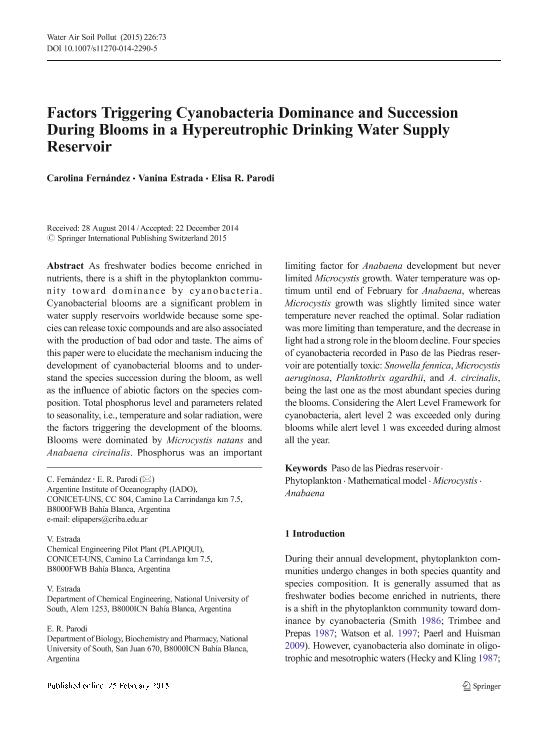Artículo
Factors Triggering Cyanobacteria Dominance and Succession During Blooms in a Hypereutrophic Drinking Water Supply Reservoir
Fecha de publicación:
03/2015
Editorial:
Springer
Revista:
Water, Air and Soil Pollution
ISSN:
0049-6979
e-ISSN:
1573-2932
Idioma:
Inglés
Tipo de recurso:
Artículo publicado
Clasificación temática:
Resumen
As freshwater bodies become enriched in nutrients, there is a shift in the phytoplankton community toward dominance by cyanobacteria. Cyanobacterial blooms are a significant problem in water supply reservoirs worldwide because some species can release toxic compounds and are also associated with the production of bad odor and taste. The aims of this paper were to elucidate the mechanism inducing the development of cyanobacterial blooms and to understand the species succession during the bloom, as well as the influence of abiotic factors on the species composition. Total phosphorus level and parameters related to seasonality, i.e., temperature and solar radiation, were the factors triggering the development of the blooms. Blooms were dominated by Microcystis natans and Anabaena circinalis. Phosphorus was an important limiting factor for Anabaena development but never limited Microcystis growth. Water temperature was optimum until end of February for Anabaena, whereas Microcystis growth was slightly limited since water temperature never reached the optimal. Solar radiation was more limiting than temperature, and the decrease in light had a strong role in the bloom decline. Four species of cyanobacteria recorded in Paso de las Piedras reservoir are potentially toxic: Snowella fennica, Microcystis aeruginosa, Planktothrix agardhii, and A. circinalis, being the last one as the most abundant species during the blooms. Considering the Alert Level Framework for cyanobacteria, alert level 2 was exceeded only during blooms while alert level 1 was exceeded during almost all the year.
Archivos asociados
Licencia
Identificadores
Colecciones
Articulos(CCT - PATAGONIA NORTE)
Articulos de CTRO.CIENTIFICO TECNOL.CONICET - PATAGONIA NORTE
Articulos de CTRO.CIENTIFICO TECNOL.CONICET - PATAGONIA NORTE
Articulos(IADO)
Articulos de INST.ARG.DE OCEANOGRAFIA (I)
Articulos de INST.ARG.DE OCEANOGRAFIA (I)
Citación
Fernandez, Carolina; Estrada, Vanina Gisela; Parodi, Elisa Rosalia; Factors Triggering Cyanobacteria Dominance and Succession During Blooms in a Hypereutrophic Drinking Water Supply Reservoir; Springer; Water, Air and Soil Pollution; 226; 3-2015; 73-85
Compartir
Altmétricas




